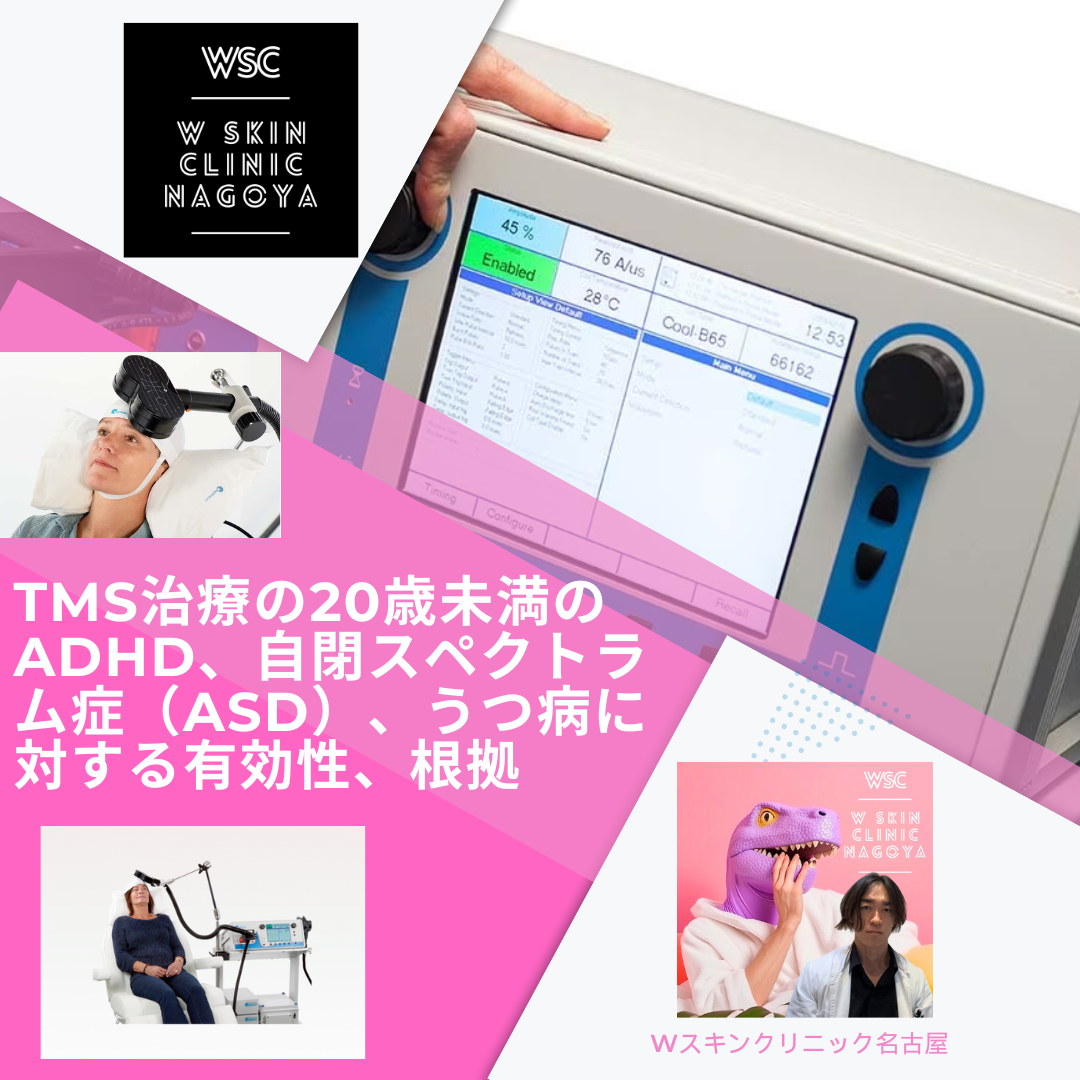NEWSお知らせ
2024.07.31|ブログ
TMS治療の20歳未満のADHD、自閉スペクトラム症(ASD)、うつ病に対する有効性、根拠、メカニズムについて名古屋の美容皮膚科医が解説

TMS治療の20歳未満のADHD、自閉スペクトラム症(ASD)、うつ病に対する有効性、根拠、メカニズムについて名古屋の美容皮膚科医が解説
こんにちは、Wスキンクリニック名古屋、院長の加藤晃司です。
TMS治療の20歳未満のADHD、自閉スペクトラム症(ASD)、うつ病に対する有効性、根拠、メカニズムについて解説します。
**経頭蓋磁気刺激(TMS)**は、非侵襲的な脳刺激技術で、主に成人のうつ病治療に使用されています。TMSの適用範囲は広がりつつあり、ADHD、自閉スペクトラム症(ASD)、うつ病などの若年患者にも有効性が検討されています。
(1)TMS治療のメカニズム
①神経伝達の調整:
TMSは、脳内の特定の領域に磁場を通じて電気的な刺激を与え、神経伝達を調整します。これにより、神経回路の興奮性が変化し、症状の改善が図られます。
②神経可塑性の促進:
TMSは、神経回路の再編成や新しい神経接続の形成を促進し、神経可塑性を高めます。これにより、脳の機能が改善され、症状が緩和されます。
③脳の特定領域の活性化:
特定の脳領域(例:前頭前野)の活動を増加させることで、気分や認知機能、注意力などの改善を目指します。
(2)ADHDに対するTMSの有効性と根拠
①有効性:
TMSはADHDの症状、特に注意力と衝動性の改善に有効であることが示唆されています。
②根拠:
一部の研究では、TMSが前頭前野の活動を調整し、ADHD患者の注意力を向上させることが示されています。
例えば、研究において、若年のADHD患者にTMSを施行した結果、注意力と衝動性が改善されたとの報告があります。
(3)自閉スペクトラム症(ASD)に対するTMSの有効性と根拠
①有効性:
TMSは、ASDの社会的コミュニケーションの改善や反復行動の減少に有効である可能性があります。
②根拠:
一部の研究では、TMSがASD患者の脳の特定の領域(例:右側の前頭前野)を刺激することで、社会的認知機能が改善されたとの報告があります。
研究の一例では、ASDの若年患者にTMSを施行した結果、社会的コミュニケーション能力が向上し、反復行動が減少したとされています。
(4)うつ病に対するTMSの有効性と根拠
①有効性:
TMSは成人のうつ病治療において有効性が確立されており、若年患者にも効果があることが示唆されています。
②根拠:
多くの研究が、TMSがうつ病の症状を軽減することを示しています。これには、前頭前野の活動を増加させることで気分を改善するメカニズムが関与しています。
一部の臨床試験では、若年のうつ病患者に対してTMSを施行した結果、症状の顕著な改善が見られたと報告されています。
まとめ
TMS治療は、20歳未満のADHD、自閉スペクトラム症(ASD)、うつ病に対して一定の有効性を持つ可能性があります。各疾患に対するTMSのメカニズムは、神経伝達の調整、神経可塑性の促進、特定の脳領域の活性化に基づいています。
ADHDに対しては、注意力と衝動性の改善が報告されています。
ASDに対しては、社会的コミュニケーションの改善と反復行動の減少が報告されています。
うつ病に対しては、気分の改善が多数の研究で支持されています。
子供への精神科内服を使うこと自体、リスクのある治療となります。
もちろん効果と副作用を天秤にかけて、使うということは場合によっては必要です。
TMS治療は薬を使わない、もしくは現在使っている薬を減薬、して治療することができる可能性があります。
臨床試験でも有効性、安全性は認められてきており、治療選択肢の一つとなります。
Wスキンクリニック名古屋での、TMS治療はこちら
https://www.w-clinic-nagoya.com/tms
Wスキンクリニック名古屋
理事長 加藤晃司
当院では無料でスタッフカウンセリングを行なっております。
お気軽にご予約くださいませ
Wスキンクリニック名古屋 (美容皮膚科)
https://www.w-clinic-nagoya.com/
〒461-0005 愛知県名古屋市東区東桜 2-4-1 第3コジマビル6F
TEL 052-7377-7117(10:00~19:00)
LINE ID @w.nagoya
高岳駅より徒歩4分 / 新栄町駅より徒歩5分
お車でお越しの方
名鉄協商パーキングチケットをお渡しいたしますので、クリニック近くのパーキングをご利用ください。
Explanation of the Effectiveness, Evidence, and Mechanism of TMS Treatment for ADHD, Autism Spectrum Disorder (ASD), and Depression in Individuals Under 20
Hello, I'm Dr. Koji Kato, Director of W Skin Clinic Nagoya.
In this article, I will explain how TMS treatment can be effective for ADHD, Autism Spectrum Disorder (ASD), and depression in individuals under 20 years old, along with the underlying evidence and mechanisms.
Transcranial Magnetic Stimulation (TMS) is a non-invasive brain stimulation technique primarily used for treating depression in adults. However, its application range is expanding, and its effectiveness for ADHD, ASD, and depression in younger patients is being studied.
- Mechanism of TMS Treatment
1.1 Regulation of Neural Transmission
TMS delivers electrical stimulation to specific areas of the brain through magnetic fields, regulating neural transmission. This changes the excitability of neural circuits, leading to symptom improvement.
1.2 Promotion of Neuroplasticity
TMS promotes the reorganization of neural circuits and the formation of new neural connections, enhancing neuroplasticity. This improves brain function and alleviates symptoms.
1.3 Activation of Specific Brain Regions
By increasing the activity of specific brain regions (e.g., the prefrontal cortex), TMS aims to improve mood, cognitive function, and attention.
- Effectiveness and Evidence of TMS for ADHD
2.1 Effectiveness
TMS has been suggested to be effective in improving symptoms of ADHD, particularly attention and impulsivity.
2.2 Evidence
Some studies have shown that TMS can regulate the activity of the prefrontal cortex, improving attention in ADHD patients. For example, research has reported that TMS applied to young ADHD patients resulted in improved attention and reduced impulsivity.
- Effectiveness and Evidence of TMS for Autism Spectrum Disorder (ASD)
3.1 Effectiveness
TMS may be effective in improving social communication and reducing repetitive behaviors in individuals with ASD.
3.2 Evidence
Some studies have reported that TMS stimulation of specific brain regions (e.g., the right prefrontal cortex) in ASD patients improves social cognitive functions. In one study, TMS applied to young patients with ASD improved social communication skills and reduced repetitive behaviors.
- Effectiveness and Evidence of TMS for Depression
4.1 Effectiveness
TMS is established as effective in treating depression in adults and has been suggested to be effective in younger patients as well.
4.2 Evidence
Numerous studies have shown that TMS can reduce symptoms of depression. This involves increasing the activity of the prefrontal cortex to improve mood. Some clinical trials have reported significant symptom improvement in young patients with depression treated with TMS.
Summary
TMS treatment has the potential to be effective for ADHD, Autism Spectrum Disorder (ASD), and depression in individuals under 20. The mechanisms of TMS for each condition include the regulation of neural transmission, promotion of neuroplasticity, and activation of specific brain regions.
For ADHD, improvements in attention and impulsivity have been reported.
For ASD, improvements in social communication and reductions in repetitive behaviors have been reported.
For depression, mood improvement has been supported by numerous studies.
Using psychiatric medications in children poses certain risks. While balancing the benefits and side effects is necessary, TMS treatment offers the potential to reduce or eliminate the need for medication.
Clinical trials have demonstrated the efficacy and safety of TMS, making it a viable treatment option.




